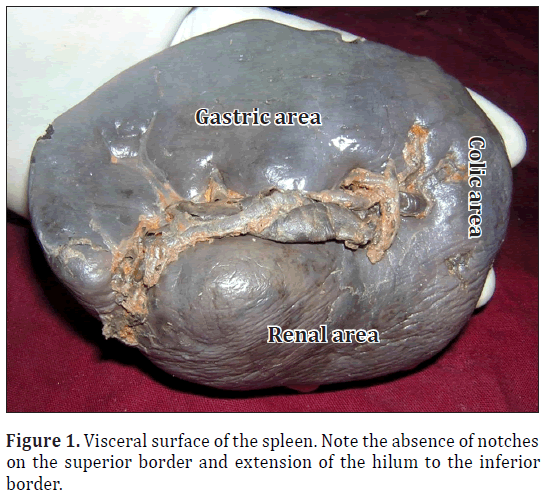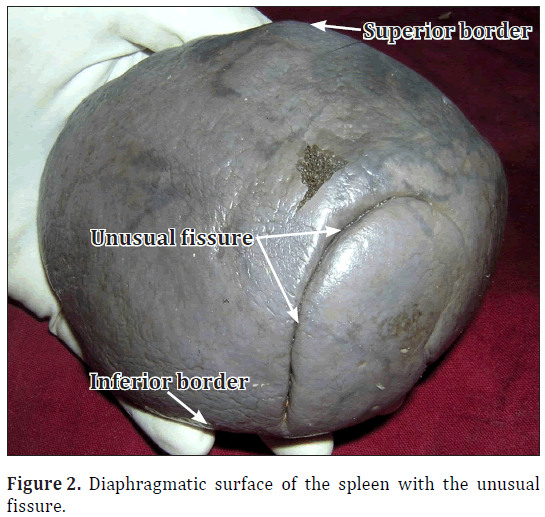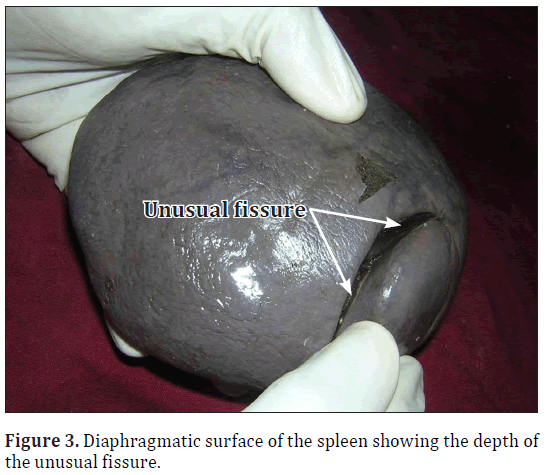Unusual fissure on the diaphragmatic surface of the spleen – a case report
Satheesha Nayak B*, Vasanth Kumar, Naveen Kumar and Raghu Jetti
Department of Anatomy, Melaka Manipal Medical College (Manipal Campus), International Centre for Health Sciences, Manipal University, Madhav Nagar, Manipal Karnataka, India
- *Corresponding Author:
- Dr. Satheesha Nayak B.
Professor and Head Department of Anatomy, MMMC Int. Centre for Health Sci. Manipal University, Madhav Nagar, Manipal, Udupi District Karnataka, 576 104, India
Tel: +91 820 2922519
E-mail: nayaksathish@yahoo.com
Date of Received: October 8th, 2011
Date of Accepted: September 22nd, 2012
Published Online: November 12th, 2012
© Int J Anat Var (IJAV). 2012; 5: 96–98.
[ft_below_content] =>Keywords
spleen, variation, fissure, unusual, peritoneum
Introduction
Spleen is the largest lymphoid organ of the body. It is situated in the left hypochondrium of the abdomen. It is covered from all the sides by peritoneum and is closely related to the fundus of the stomach, left kidney, left colic flexure and the diaphragm. It has an anterior end and a posterior end; superior, inferior and intermediate borders; diaphragmatic and visceral surfaces. Its superior border shows variable number of splenic notches. Its diaphragmatic surface is totally covered by peritoneum and usually does not show any notches or fissures. The diaphragmatic surface may show grooves formed by the 9th, 10th, and 11th ribs. The shape of the organ depends on the surrounding viscera and it varies from a wedge shape to a tetrahedron. Knowledge of variations of spleen is important for radiologists. We observed an unusual notch on the diaphragmatic surface of the spleen.
Case Report
During regular dissections for the medical undergraduates at Melaka Manipal Medical College (Manipal Campus) we observed the variations in a spleen belonging to an adult male cadaver. The spleen looked normal and healthy with a greyish purple color and normal dimensions. However, it did not have splenic notches on the superior border (Figures 1,2). The hilum extended to the inferior border by cutting the intermediate border and admitted the passage of the splenic vessels (Figure 1). There was an unusual ‘C’ shaped fissure on the diaphragmatic surface of the spleen. This fissure was about 5 cm long and 2.5 cm deep and the visceral peritoneum extended to the depth of the fissure (Figures 2,3). The lower/anterior end of the fissure almost touched the inferior border.
Discussion
Until recently, the spleen was considered to be a less significant organ [1] but now it is known to be important in circulatory and immune systems. It develops from the mesoderm in the cranial part of the dorsal mesogastrium in the sixth week of intra-uterine life [2,3]. During the early development, the spleen is represented by a few splenic nodules which eventually fuse to form the spleen. Some of these nodules may get separated from the rest and develop independently. This will result in the formation of accessory spleens. The embryological reason for having notches on the superior border is the improper fusion of the splenic nodules along the superior border during development.
In the current case there were no notches on the superior border. That means there was perfect fusion of all the splenic nodules along the superior border during its development.
One of the most common congenital anomalies of the spleen is the presence of accessory spleens in various parts of the abdomen in addition to the main organ [4]. The accessory spleens are seen in about 10-15% of individuals, out of which 1-2% may be located in the tail of the pancreas [5]. According to the studies conducted by Souparis et al., [6] presence of retroperitoneal accessory spleens may mimic retroperitoneal tumors with the history of epigastric pain, intermittent nausea and vomiting. In various studies in the past, splenic notches were observed in 70-98% of cases [7–10].
Some of the past studies have reported the presence of unusual fissures on the spleen. The study by Srijit Das et al., [10] has reported the presence of a variant fissure on the diaphragmatic surface of only one spleen out of 100 spleens studied. Presence of unusual fissures of the diaphragmatic surface may be mistaken for lacerations of the spleen in case of radiological observations of the abdominal trauma. A case of large congenital fissure mimicking splenic hematoma was observed in splenic scintigraphy by Smidt [11].
The congenital fissures like the one being reported by us probably result due to the improper fusion of the splenic nodules during development or due to the pressure by the nearby viscera. They may result in serious misdiagnosis as splenic hematoma in radiological examinations. The danger of wrong diagnosis is more due to the rarity of the existence of such fissures on the diaphragmatic surface.
References
- Jakubovsky J, Porubsky J. Functional morphology of the spleen. The current knowledge. Bratisl Lek Listy. 1995; 96: 637–641. (Slovak)
- Standring S, ed. Gray’s Anatomy. The Anatomical Basis of Clinical Practice. 39th Ed., New York, Elsevier Churchill Livingstone. 2005; 1239-1244.
- Sadler TW. Langman’s Medical Embryology. 9th Ed., Baltimore, Lippincott Williams & Wilkins. 2000; 277.
- Gayer G, Hertz M, Strauss S, Zissin R. Congenital anomalies of the spleen. Semin Ultrasound CT MR. 2006; 27: 358–369.
- Weiand G, Mangold G. Accessory spleen in the pancreatic tail - a neglected entity? A contribution to embryology, topography and pathology of ectopic splenic tissue. Chirurg. 2003; 74: 1170–1177. (German)
- Souparis A, Papaziogas B, Alexandrakis A, Koutelidakis J, Paraskevas G, Papaziogas T. An unusual case of retroperitoneal accessory spleen with vascular supply directly from the aorta. Minerva Chir. 2002; 57: 513–515.
- Soyluoglu AI, Tanyeli E, Marur T, Ertem AD, Ozku K, Akkin SM. Splenic artery and relation between the tail of the pancreas and spleen in a surgical anatomical view. Karadeniz Tip Dergisi. 1996; 9: 103–107.
- Skandalakis PN, Colborn GL, Skandalakis LJ, Richardson DD, Mitchell WE Jr, Skandalakis JE. The surgical anatomy of the spleen. Surg Clin North Am. 1993; 73: 747–768.
- Ungor B, Malas MA, Sulak O, Albay S. Development of spleen during the fetal period. Surg Radiol Anat. 2007; 29: 543–550.
- Das S, Abd Latiff A, Suhaimi FH, Ghazalli H, Othman F. Anomalous splenic notches: a cadaveric study with clinical importance. Bratisl Lek Listy. 2008; 109: 513–516.
- Smidt KP. Splenic scintigraphy: a large congenital fissure mimicking splenic hematoma. Radiology. 1977; 122: 169.
Satheesha Nayak B*, Vasanth Kumar, Naveen Kumar and Raghu Jetti
Department of Anatomy, Melaka Manipal Medical College (Manipal Campus), International Centre for Health Sciences, Manipal University, Madhav Nagar, Manipal Karnataka, India
- *Corresponding Author:
- Dr. Satheesha Nayak B.
Professor and Head Department of Anatomy, MMMC Int. Centre for Health Sci. Manipal University, Madhav Nagar, Manipal, Udupi District Karnataka, 576 104, India
Tel: +91 820 2922519
E-mail: nayaksathish@yahoo.com
Date of Received: October 8th, 2011
Date of Accepted: September 22nd, 2012
Published Online: November 12th, 2012
© Int J Anat Var (IJAV). 2012; 5: 96–98.
Abstract
Variations in the size and shape of the spleen are common. But the variations of its diaphragmatic surface are extremely rare. Since the variations are rare, they become clinically important when they exist. We found a deep fissure on the diaphragmatic surface of a spleen. The fissure was quite deep and the peritoneum entered the depth of the fissure in a similar manner as pleura entering the fissures of the lung. There were no notches on the superior border of this spleen.
-Keywords
spleen, variation, fissure, unusual, peritoneum
Introduction
Spleen is the largest lymphoid organ of the body. It is situated in the left hypochondrium of the abdomen. It is covered from all the sides by peritoneum and is closely related to the fundus of the stomach, left kidney, left colic flexure and the diaphragm. It has an anterior end and a posterior end; superior, inferior and intermediate borders; diaphragmatic and visceral surfaces. Its superior border shows variable number of splenic notches. Its diaphragmatic surface is totally covered by peritoneum and usually does not show any notches or fissures. The diaphragmatic surface may show grooves formed by the 9th, 10th, and 11th ribs. The shape of the organ depends on the surrounding viscera and it varies from a wedge shape to a tetrahedron. Knowledge of variations of spleen is important for radiologists. We observed an unusual notch on the diaphragmatic surface of the spleen.
Case Report
During regular dissections for the medical undergraduates at Melaka Manipal Medical College (Manipal Campus) we observed the variations in a spleen belonging to an adult male cadaver. The spleen looked normal and healthy with a greyish purple color and normal dimensions. However, it did not have splenic notches on the superior border (Figures 1,2). The hilum extended to the inferior border by cutting the intermediate border and admitted the passage of the splenic vessels (Figure 1). There was an unusual ‘C’ shaped fissure on the diaphragmatic surface of the spleen. This fissure was about 5 cm long and 2.5 cm deep and the visceral peritoneum extended to the depth of the fissure (Figures 2,3). The lower/anterior end of the fissure almost touched the inferior border.
Discussion
Until recently, the spleen was considered to be a less significant organ [1] but now it is known to be important in circulatory and immune systems. It develops from the mesoderm in the cranial part of the dorsal mesogastrium in the sixth week of intra-uterine life [2,3]. During the early development, the spleen is represented by a few splenic nodules which eventually fuse to form the spleen. Some of these nodules may get separated from the rest and develop independently. This will result in the formation of accessory spleens. The embryological reason for having notches on the superior border is the improper fusion of the splenic nodules along the superior border during development.
In the current case there were no notches on the superior border. That means there was perfect fusion of all the splenic nodules along the superior border during its development.
One of the most common congenital anomalies of the spleen is the presence of accessory spleens in various parts of the abdomen in addition to the main organ [4]. The accessory spleens are seen in about 10-15% of individuals, out of which 1-2% may be located in the tail of the pancreas [5]. According to the studies conducted by Souparis et al., [6] presence of retroperitoneal accessory spleens may mimic retroperitoneal tumors with the history of epigastric pain, intermittent nausea and vomiting. In various studies in the past, splenic notches were observed in 70-98% of cases [7–10].
Some of the past studies have reported the presence of unusual fissures on the spleen. The study by Srijit Das et al., [10] has reported the presence of a variant fissure on the diaphragmatic surface of only one spleen out of 100 spleens studied. Presence of unusual fissures of the diaphragmatic surface may be mistaken for lacerations of the spleen in case of radiological observations of the abdominal trauma. A case of large congenital fissure mimicking splenic hematoma was observed in splenic scintigraphy by Smidt [11].
The congenital fissures like the one being reported by us probably result due to the improper fusion of the splenic nodules during development or due to the pressure by the nearby viscera. They may result in serious misdiagnosis as splenic hematoma in radiological examinations. The danger of wrong diagnosis is more due to the rarity of the existence of such fissures on the diaphragmatic surface.
References
- Jakubovsky J, Porubsky J. Functional morphology of the spleen. The current knowledge. Bratisl Lek Listy. 1995; 96: 637–641. (Slovak)
- Standring S, ed. Gray’s Anatomy. The Anatomical Basis of Clinical Practice. 39th Ed., New York, Elsevier Churchill Livingstone. 2005; 1239-1244.
- Sadler TW. Langman’s Medical Embryology. 9th Ed., Baltimore, Lippincott Williams & Wilkins. 2000; 277.
- Gayer G, Hertz M, Strauss S, Zissin R. Congenital anomalies of the spleen. Semin Ultrasound CT MR. 2006; 27: 358–369.
- Weiand G, Mangold G. Accessory spleen in the pancreatic tail - a neglected entity? A contribution to embryology, topography and pathology of ectopic splenic tissue. Chirurg. 2003; 74: 1170–1177. (German)
- Souparis A, Papaziogas B, Alexandrakis A, Koutelidakis J, Paraskevas G, Papaziogas T. An unusual case of retroperitoneal accessory spleen with vascular supply directly from the aorta. Minerva Chir. 2002; 57: 513–515.
- Soyluoglu AI, Tanyeli E, Marur T, Ertem AD, Ozku K, Akkin SM. Splenic artery and relation between the tail of the pancreas and spleen in a surgical anatomical view. Karadeniz Tip Dergisi. 1996; 9: 103–107.
- Skandalakis PN, Colborn GL, Skandalakis LJ, Richardson DD, Mitchell WE Jr, Skandalakis JE. The surgical anatomy of the spleen. Surg Clin North Am. 1993; 73: 747–768.
- Ungor B, Malas MA, Sulak O, Albay S. Development of spleen during the fetal period. Surg Radiol Anat. 2007; 29: 543–550.
- Das S, Abd Latiff A, Suhaimi FH, Ghazalli H, Othman F. Anomalous splenic notches: a cadaveric study with clinical importance. Bratisl Lek Listy. 2008; 109: 513–516.
- Smidt KP. Splenic scintigraphy: a large congenital fissure mimicking splenic hematoma. Radiology. 1977; 122: 169.









